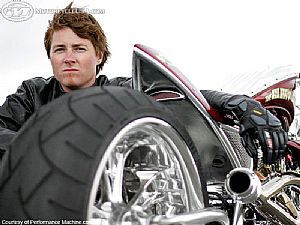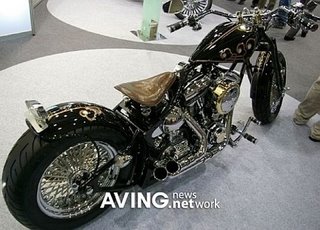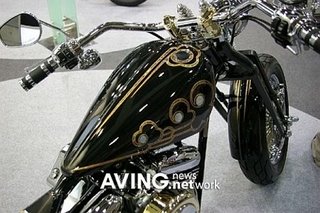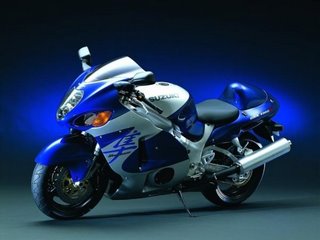
 Roland Sands: The Glory Stomper
Roland Sands: The Glory Stomper 
7/22/2005
By Peter Jones Recovery Discovery Chopper
Although he's considered one of the greatest filmmakers of all time, Stanley Kubrick never won an Academy Award for his directing. His films were too edgy, too provoking, too different, and too personal, to receive a wide embrace, although those are also the reasons his films will endure while most of their contemporaries fade.
In the world of custom chopper builders, methinks Roland Sands will suffer that same fate. Sands does it all wrong. Sands creations are over the edge. Sands creations are rooted in the historical traditions of chopper culture, but he turns the concept inside out, swings it over his head and tosses it down the street.
Sands built The Glory Stomper bike for the Discovery Channel's Biker Build-Off program, (you can get a DVD of the show at:
Discovery.com) competing against Arlen Ness. Sands' bike lost out in the popular vote, but for viewers at home, he stole the TV show. He then went on to be voted best new builder by his peers.
The Glory Stomper is named after the 1967 American International biker film, The Glory Stompers, staring Dennis Hopper. Sands said he planned the bike to be a twisted, rebellious, ruffian statement redefining what a chopper is, and that film's title and tone set the mood. As with all of Sands' creations, The Glory Stomper is inspired by the rich heritage of chopperdom. Steeped in this history, Sands uses it as solicitous stimulation, not for mundane mimicry. By naming the bike after a movie from the heyday of bike-exploitation films, Sands gives this chopper historical reference for his irreverent homage. It's his disrespect of the culture he cherishes that gives his bikes their brilliant edge. Because of that, Sands' choppers are high art that question perceptions of rebellion, freedom, sex, style, and the merchandizing of bad.
In following the bike's Frankenstein theme of a modern Prometheus, Sands wanted Stomper to be something exceptional made from something crappy. So he started with a crashed Harley-Davidson Softail picked up at a local junkyard. Just to make sure it was properly seasoned, Sands launched it off the back of his truck upon return to Performance Machine, site of
Roland Sands Designs.
The frame was completely stripped and modified, and the engine sent to famed Salt Flats bike builder Wink Eller. The crank was balanced and blueprinted, and a set of Edelbrock heads installed after they were properly ported. Valves, pistons, cylinders, camshafts, lifters, and pushrods are all S&S. An Edelbrock carb is used and the air cleaner is a custom one-off by Sands, shaped and painted to complement the fuel tank. The ignition is by Twin Tech and the exhaust was hand built by Rolland and Brett, all the way to its beehive tip. The valve and ignition covers were designed by Sands and are available in the
Performance Machine Contour line of products. The Contour stuff is new for 2005 and has what Roland calls a trippy finish.
The mods to the frame were so extensive Sands could have just as easily started with a bent bicycle and a washing machine. So modified is the wrong word. The frame was basically built from the ground up from pieces that coincidentally happened at one time to be on another motorcycle. The backbone was stretched two inches and the downtube stretched an inch. Rake was set at 35 degrees and the swingarm was built from scratch and uses the chain adjusters off the poor, dusty Yamaha TZ250 Sands once used to race. This required building new swingarm mounts and the subframe under the seat was fabricated from scratch. So, why again did Sands bother starting with that Softail? Just to make a point.
The rear shock is Ohlins, tucked up under the engine like H-D did it. The forks are also by Ohlins and the right one is sans brakes while the left carries a PM-brand radial-mount four-piston caliper. The triple clamps are made from machine billet aluminum. The forks are also fitted with a steering damper. Rims, front and rear, are of course PM Contour Method, and the rotor, brake, and clutch master are also by PM. The rear rim is 8.5 inches and carries a 240/40 Metzeler tire. The handlebars are custom, formed in a clubman style with the crossover tube curving down from a couple knuckle bosses, and painted to match the tank, air cleaner, and tailsection.
For a riding position to match the bars, the footpegs were moved back and mounted to the engine and primary-drive case. The seat is a pad used on the TZ250.
The most radical and eye-catching feature of Glory Stomper is the gas tank, with its Sands built billet aluminum top over a steel pan fabricated by Johnny Chop. The cover is machined with ribs reflected in the custom front-mounted oil bag, engine covers and exhaust tip, giving the bike a look of retro performance. The oil tank was cast by Jeff Decker and its mount built by T. Foster. The custom paint was applied by Chris Wood of
Air Trix.
Like all of Sands' choppers, The Glory Stomper ain't got no gauges. Sands doesn't like the way gauges look, and having been a road racer he's used to riding by sound and feel. The headlight is a mini projector beam and the taillight is incorporated into the bottom of the tailsection, giving the machine a bit of a sportbike look. The blinkers were fabricated with the same care and respect as the gauges.
On Biker Build-Off, the choppers were judged at a bikeweek event in Puerto Rico in late November. The episode of the event is definitely one of the most entertaining because Sands made sure to step up the action and drama. The kid plays it from the heart and you can't turn away.
The Glory Stomper in many ways defies classification. Is it a chopper or a bob-job? Or is it something else? It's probably all those things. And paramount to all of Sands' bikes is that they perform. So this thing works. It handles, it goes, it stops, it even does wheelies. It's bad.
Sands gives credit to his hero Indian Larry, who has been an inspiration for his style of building bikes that are much more than great looking or great to ride. And as many know, Larry gave homage to Big Daddy Roth, and the krazy kulture of the sixties. None of this is lost on Sands. His aesthetic is complex yet subtle. You don't need to notice, but if you do, there's much to see and contemplate.


































